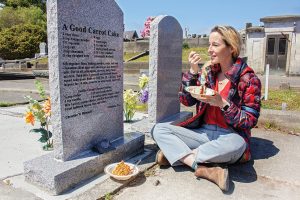
During the pandemic, Christian County (Mo.) Library was looking to launch an ongoing service series that would bring staffers and patrons together outdoors. So it turned to some of the rural area’s oldest and most scenic spaces: cemeteries.
In 2021, the library started its Uncovering History: Gravestone Cleaning program series. Participants meet monthly from May to October and have brought new life to hundreds of headstones. Not only has the project succeeded in convening the community around a common goal, but it has also eased often-difficult conversations around death.
After a year of virtual programming and social distancing, staffers at Christian County (Mo.) Library (CCL) were ready to return to in-person events. As videos of people cleaning headstones began popping up on Instagram and TikTok, we thought we could replicate the practice with our patrons.
To ensure our cleaning techniques would not be harmful, we consulted a local historian and archaeologist from a nearby university. With sponsorship from the Christian County Friends of the Library, we purchased the tools and cleaners needed to safely remove debris: brushes, plastic scrapers, water sprayers, and D/2 Biological Solution, a biodegradable liquid cleaner designed to remove algae, moss, and similar organisms from architectural surfaces.
Graveyards are scattered throughout our largely rural county, ranging from small family plots to city-owned cemeteries with thousands of headstones. Official records indicate more than 60 unique cemeteries in CCL’s service area, while other counts are closer to 100.
We quickly identified several sites that had older stones in need of cleaning. The challenge was identifying the right people who could grant approval for our program. We looked for signs on cemetery gates and asked funeral homes for contact information for groundskeepers and caretakers. The enthusiastic responses we received reinforced the need for this kind of service. Many caretakers told us it is typical to have only a few people involved in the upkeep for an entire cemetery, most of whom are volunteers.
Our first headstone cleaning meetup was held in October 2021. After the last brush was dried and the final participant left, we knew we had created something special.
Over three summers, CCL has visited eight cemeteries and collectively revived more than 200 headstones, most of which were placed in the 1920s. Depending on the weather, the group’s size ranges from two to 12 volunteers. The program has attracted children to seniors—some out of an interest in local history and genealogy and others who are simply looking for an open-air, community-oriented Saturday activity. Some have joined the program specifically to clean the headstones of loved ones and ancestors, but most are drawn to plots that appear neglected or overgrown. We have even had a few cemetery caretakers attend to learn more about our process.
Each session begins with a CCL staffer doing a cleaning demonstration and providing instructional handouts. We identify and choose stones with no physical damage, like wobbles or cracks, or signs of sugaring, erosion that leaves stones with granular-looking surfaces. After selecting stones, teams get to work scraping off biological growth with plastic putty knives, scrubbing surfaces with solution, and spraying the headstones with water. We provide gloves and direct participants to spray the D/2 where they will not be breathing it in.
Removing a century’s worth of grime and growth, one scrape or scrub at a time, provides immediate gratification.
Throughout the project, we’ve uncovered some interesting stories. One gravestone we cleaned belonged to a local named Laony Carver. The stone claimed Carver was 114 when she died in 1922, but upon further research, we found her age was likely embellished. Even so, Carver survived the Civil War and outlived many. Her husband’s death left her with three children under age 5, so she made money driving oxen to haul lumber to the courthouse when it was under construction.
Removing a century’s worth of grime and growth, one scrape or scrub at a time, provides immediate gratification. However, the true magic has been the conversations among participants. They have discussed cultural differences surrounding death, last wishes, burial customs, and experiences losing loved ones. These topics seem somehow more comfortable in the context of being in a graveyard, doing this kind of work.
The feedback from cemetery officials and patrons has been overwhelmingly positive. One of the board members of a cemetery we visited expressed her surprise and delight about how many people showed up, particularly younger participants with no personal connections to the site.
This program is not just a restoration effort. It is a celebration of community, history, and the enduring spirit of those who came before us. Each visit is a step toward preserving legacies etched in stone, ensuring they will continue to endure for generations to come.


